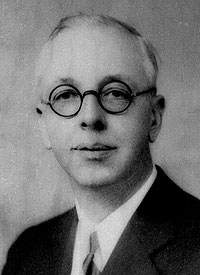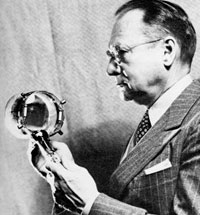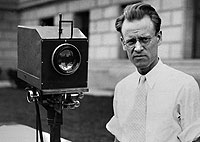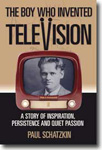

 |
The Farnsworth
Invention: Fact -v- Fiction
|
 |
Act II, Scene 5: In which both sides come out swinging |
| The Play |
The Facts
|
|
| As the action ramps up toward the inevitable courtroom confrontation, Farnsworth is introduced to his patent attorney, Donald Lippincott. | Donald K. Lippincott was an attorney for the Los Angeles based firm of Evans and Evans when he wrote Farnsworth's first patent applications in 1926-27. Lippincott was an insightful engineer as well as a gifted attorney, and his inspired use of language instrumental in creating Farnsworth's iron-clad patent portfolio. Lippincott continued to be Farnsworth's patent attorney well into the 1930s. |
 Donald K. Lippincott, Farnsworth's patent attorney starting in 1926 |
| William Crocker informs Farnsworth that Zworykin has transmitted a picture. "I'm sure he did," Phil says, "we showed him how to." | Yup. He sure did. Because he thought Zworykin had come to investigate a patent license for Westinghouse. So "Crocker's" surprise at this revelation is not consistent with the facts. All of Farnsworth's backers will well aware of Zworykin's visit, which had been arranged under false pretenses. |
|
| One of the players says "RCA bought Westinghouse" so that RCA could control Zworykin's 1923 patent. | RCA never 'bought' Westinghouse, but they did go to bat for that patent. | |
| Crocker says "it's a very good picture" (i.e. the "light problem" has been solved) and Farnsworth asks "you mean he stole from us or he's got something we don't have?" Farnsworth''s answer of "both" sets up the coming patent litigation. | In the ensuing litigation, Zworykin tried to make the case that a) the tube he was experimenting with in the 1930s was the same tube he'd been trying to patent since 1923 and b) that it scanned its image in the same way as disclosed Farnsworth's 1927/30 patent. If true on both counts, Zworykin would be entitled to "priority of invention." We'll see how that turns out... |  Vladimir Zworykin admiring the device he wishes he had invented in 1923 |
| Lippincott says "we're going to file a patent interference.." | By 1934, it was clear that RCA had intimidated the entire radio industry out of doing any kind of business with Farnsworth, on the grounds that Zworykin's 1923 application would set the industry standard and erase Farnsworth's priority. Farnsworth's attorney's took the offensive, and launched patent interference proceedings against Zworykin and RCA. | |
| When asked if there was anything Zworykin saw in Farnsworth's lab that might have given him a clue, Farnsworth recalls Cliff Gardner showing Zworykin how to form a "pyrex seal." | The ability to seal flat optical glass into the end of an Image Dissector was a novel fabrication process, but was not an instrumental element of the underlying art, nor an issue in the patent litigation. |  By 1934, the convergence of opposing forces is beginning to show |
| A memorial service is held in New York for Thomas Edison, at which David Sarnoff encounters Pem Farnsworth and offers condolences on the loss of her son. | Other than the fact that Edison died (on October 18, 1931), this entire scene is fiction; The Farnsworth's son died in March, 1932. | |
| During her conversation with Sarnoff, Pem describes how her husband invented an auto ignition lock when he was 12 years old. | That part is true. |
|
| When Pem asks what he was doing when he was 12 years old, Sarnoff says "that would have been two years after my family was run out of our house by Cossacks..." | That part is not true. |
|
Want the whole story? Read a Book! |
 The Boy Who Invented Television A Story of Inspiration, Persistence, and Quiet Passion by Paul Schatzkin |
|